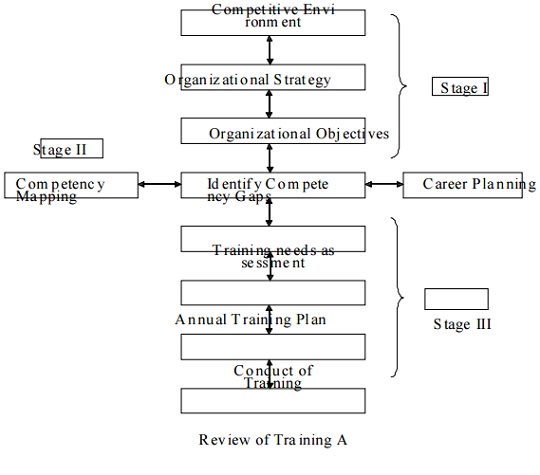Chapter: Mechanical : Human Resource Management(HRM) : Training And Executive Development
The Process of Executive Development
Process
Contemporary organizations have realized the importance of human capital and increasingly finding its necessary to continuously train and develop human resources. The training and development needs of the employees cannot be looked at in isolation; any proactive organization has to view the individual training needs in the overall organizational context. The training and development processes are not longer adjunct to other departments but have become a part of organizational strategy and one of the key organizational objectives. The process of arriving at the development needs of the executives can be comprehensively viewed through the process given in Fig.-

The Process of Executive Development
Stage I: In the Stage I, at the macro level, there are three key elements are considered as competitive advantage, organizational strategy and organizational objectives. The analysis of competitive environment helps the organization to decide its competitive positioning in the market place, based on which the organizational strategy is drawn out in an attempt to transform or reposition of the organization. The macro view is broken down into specific organizational objectives for further dissemination to functional/ departmental, and individual level.
Stage II: This stage is most important and crucial phase of executive development process. This stage deals analysis on the competency mapping, identification of competency gap and career planning. In the competency stage which helps to capture the competencies of all the employees of the organization which includes the capacities of the management also. In the second stage, the organizational requirements and competency gap to be analyzed. In the third phase, this deals with identifying and verifying the organizational needs, individual growth and along with career planning of the executives.
Stage III: This stage is consisting of three levels. The first level of this stage deals with the activities involving training need assessment of individuals and of all employees based on which Annual Training Plan (ATP) is drawn. Based on the annual training plan the employees are chosen to expose to either corporate training program, for internal training programs and external organizations. While deciding the venue and types and nature of the training program the personnel department and training facilitator should consider the various issues like no of executives, cost, outsourcing and availability of technical expertise in the organizations. In case of organizational development related exercises, the combination of internal and external training programs should be arrange for the all employee of the organization.
Though the money, infrastructure and finally the manpower to be utilized in the whole process keeping into this, the top management has to take decision in this regard. The training department, management and HR Department should work in union. It is a collective phenomenon, which is mostly initiatives, motives of the top management. If entire process of executive development is mostly determined by its efficacyand its effectiveness.
Apart from this the process of executive development can be defined in several other ways with slight difference.
The process of executive development is as follows:
1. Analysis of Development Needs: First of all the present and future development needs of the organization are ascertained. It is necessary to determine how many and what type of executives are required to meet the present and future needs of the enterprise.
2. Appraisal of the Present Managerial Talent: A qualitative assessment of the existing executives is made to determine the type of executive talent available within the organization.
3. Planning Individual Development Programmes: Each one of us has a unique set of physical, intellectual and emotional characteristics. Therefore, development plan should be tailor-made for each individual.
4. Establishing Training and Development Programme: The HR department prepares comprehensive and well conceived programmes.
5. Evaluating Developing Programs: Considerable money, time and efforts are spent on executive development programmes. It is therefore natural to find out to what extent the programme‘s objective has been achieved.
Related Topics